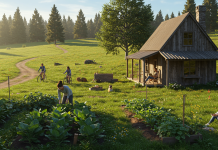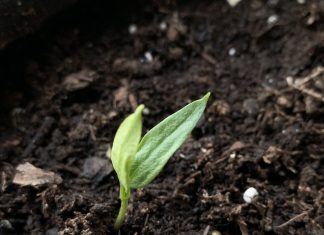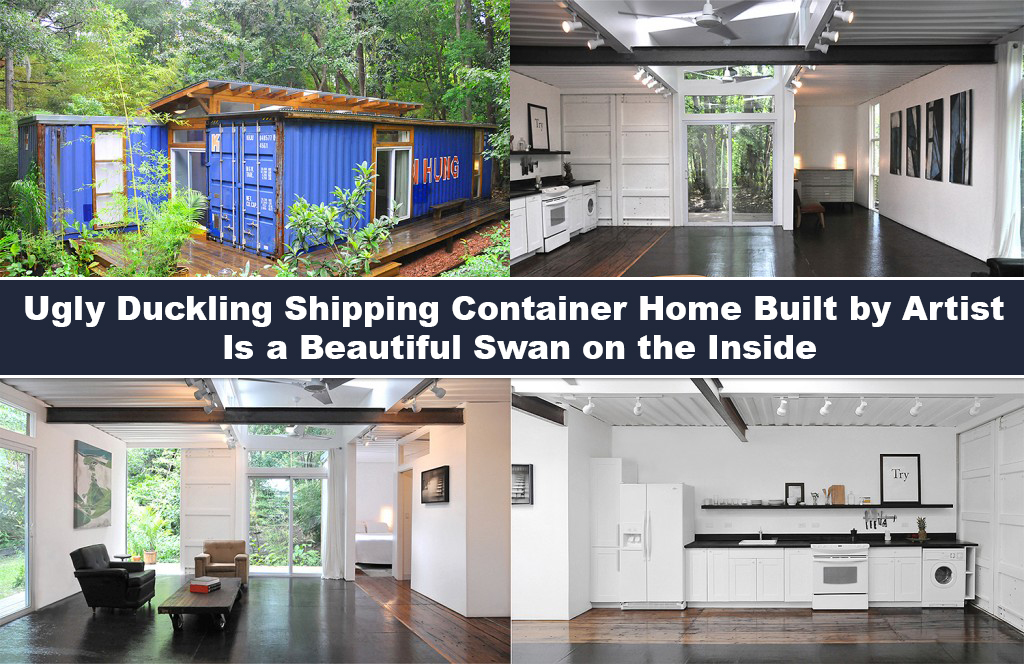Want to go off grid? What’s your off grid dream? Build your own cabin in the mountains, grow your own healthy food, fruits and veggies in your own garden? Install solar power system with a battery backup for energy storage? Thumbing your nose at the man? We all have that off grid dream to be 100% self sufficient, self reliant, independent and free. Here are the 12 things you need to build your off grid dream and make it a reality.
- Buy Land: PAY CASH! GOOD LOCATION! Doesn’t much matter what kind of land it is, it just needs to be in a good location and meet a few important must have criteria. Location is key. That is the most important thing besides water and how you’ll handle septic and power.
- Use Natural/Locally Sourced Materials: Build your off grid dream from your own land. Natural building materials are also important. You should try to build your off grid home/cabin with locally gathered materials where possible. Though this is the ideal situation you might not be able to as you may not be able to get a large enough piece of land that can supply the amount of materials needed.
READ: How To How to Find Land To Live Off Grid:
(this is an excerpt from my expanded article here)
The Short List
- Remote Land Equals Cheap Land (usually)– The further away from civilization the cheaper it will be.
- Remote Equals Fewer Restrictions/Ordinances – The further away from civilization the fewer restrictions you’ll have and the more freedom you’ll have to build and do what you want without someone telling you you can’t.
- No Building Codes or Codes not enforced – No building codes or a property located in an area where the county doesn’t really enforce the codes is best. This usually means remote. Even if there are codes you need to worry about there are still good properties available, but they will limit what you can do and build, and will ultimately cost you more money out of pocket upfront. Either way, make sure that your home build is durable and up to standards. For instance, the commercial roofing system of your property should be built by a professional roofing contractor to ensure its quality and durability.
- Year Round Access – Make sure you have access to the property year round. In some places winter and monsoon season can make accessing the property impossible. Good roads are key. Think about how you’re going to get your materials and tools and equipment onto your land.
- Legal Access – Make sure you have LEGAL right of way access to the property. No “land-locked” properties where you have to cross someone else’s land to access your land.
- No Legal Issues, (Encumbrances) Liens or Back Taxes Due – Do a title search.
- Do a Survey! – Have the property surveyed by a licensed and insured surveyor because if you don’t and there’s a property dispute later it can cost your thousands or tens of thousands of dollars and or cause the loss of your building/cabin if it’s on the disputed land. Always make sure the property boundaries are clearly marked and you know where they are and every matches the contract/sale/advertisement.
- Have The Water/Soil Tested For Contaminants! – This is very important. You don’t want to buy a cheap property and build your dream cabin only to discover that your land was a former mining site and is contaminated with poisonous chemicals that will make you and your family sick.
- Pay Cash! – You don’t want to live on a remote property with a mortgage. Bad idea! If something happens and you can’t make payments then you’re in a bad place and could lose everything. Don’t get a mortgage. Beg, borrow and sell whatever you need to raise the funding needed to pay CASH for your land. Don’t go into debt to buy your dream property. Sell ALL your personal items you can afford to sell and use that cash to buy land. Items like jewelry and electronics—such as laptops, smartphones, tablets, cameras, and gaming consoles—can fetch good prices at Trusted Pawn Shop Las Vegas. If you don’t want to sell your stuff, then ask yourself this. “What’s more important to me…my STUFF or my dream of living off grid, independent, self sufficient, self reliant and FREE!”. The answer should be FREEDOM! Pay cash for your land. Never get a mortgage. Ever!
- Mineral Rights & Water Rights! – Make sure you secure mineral rights (including water rights). If you like a property and the mineral rights don’t come with it then STOP! Back away and find a different property. I don’t care how good the property is, you do NOT want someone coming in and digging and drilling on your land, because that’s exactly what will happen if there are valuable minerals/oil or whatever found in your area. The person or company who owns the mineral rights or water rights will have the right to be on your land to extract the minerals or water and you will be powerless to stop them.
- DO YOUR HOMEWORK! – Make sure you check all the local, county, state and federal laws. If you’ve done your homework you’ll have decades of awesome wonderful off grid living.READ THE FULL ARTICLE HERE:
How To How to Find Land To Live Off Grid:
Next are the things you’ll need to build.
3. Build Workshop/Pole Barn: The first thing you need to build will be workshop. You’d think your cabin would be first, but I’m telling you, you’re going to need a place to store tools and equipment. You can sleep in the barn for the time being, or if you’re the type that needs more comfort then buy yourself one of those portable buildings/sheds. They’re only a few thousand dollars and you don’t need all the money upfront. You can rent to own the building from this web link for a few hundred bucks a month. It’s more expensive than building one yourself, BUT the point is to maximize your efficiency and spend less time exposed to the elements. If comfort and efficiency is your thing, then get the shed and convert it into a little cabin. Then use that to sleep in and build your workshop. You’ll need the workshop to be able to build everything else. If you’re ok with sleeping in the workshop/barn then it will double as your shelter until your get a temporary dwelling setup. This saves you a lot of money.
4. Build Solar & Wind Power System: This is key to getting things done. Gotta have power. This is going to cost money. But for about $2.5k to $5k you can have a pretty nice system. If that’s too expensive then purchase a small 2500W gas or diesel (preferably diesel) powered generator to power your tools and equipment and charge your battery banks. Build a battery backup energy storage system. This is imperative. I see too many people trying to run their whole off grid homestead off of just solar without batteries. Don’t do that. Spend the money on a good battery backup energy storage system.
However, it’s important to have a reliable power system when building an off-grid homestead. Investing in solar and wind power is a great way to achieve this. However, it can be a significant cost upfront. To make the investment more manageable, reach out to a reputable electrical contractor like suburbanenterprises.com. They can offer expert advice on the best system for your needs and budget, as well as installation services to ensure everything is set up correctly. Don’t skimp on the battery backup energy storage system, as it’s a crucial component to keeping your power running smoothly. With the right system in place, you can enjoy the freedom of living off the grid without sacrificing the modern conveniences of electricity.
5. Build Septic System: If you’ve never done this before it can be a daunting task. If you’ve got the money pay someone to do it. Some counties/states require that you have a licensed contractor install your septic. I personally think this is a “legal” scam and just a way for the county/state to make more money (in taxes and kickbacks) by overcharging and ripping off consumers, but that’s just me. If you’ve picked a good property then the small zoning and planning office for your county may or may not look the other way or be as strict with the rules on this. You will be required to have an inspector inspect it and give the go ahead but this should be relatively easy if you’ve done our homework and know what you’re doing. I’ve done this work before so as long as I get my permits and pick a parcel of land in a county that allows me to build our my septic system, then I should be ok there. Make sure you do your homework and DO NOT BREAK THE LAW. (I have to say that for legal reasons).
6. Build Log Cabin with Loft & MAYBE a Basement & Upper Viewing Deck/Patio (dreaming big): This will be your main residence. I’ve seen people build their cabin fast and I’ve seen people take years to build. Maybe you can build faster. It really depends on the permitting and cost to meet building codes and zoning requirements. Which is why you should do your homework and really research every step things will go more smoothly than if you just jumped into a piece of land and tried to build your off grid cabin.Don’t buy the land until you know all the zoning, land use ordinances and restrictions for septic, water and utilities. Doing your homework ahead of time will save you time and money later. You can’t plan for everything, but you can do your own due diligence in the beginning and stop problems before they happen. A well-constructed roof is vital for long-term cabin sustainability. For more information on finding the right roofing service, simply click for source.
7. Build Aquaponics Hoophouse Greenhouse: This is another small project you can get done in a short time and one that needs to be done first so you can have food faster. The quicker you get this built the faster you’ll have fresh fruit and veggies to eat. At least the framing and roof part will be fast to build. The aquaponics part will take 4 months. 1 month to build the greenhouse itself and 3 months to grow. Now, the roof installation shouldn’t take more than a few days to build. In this case, it is best to take professional help from the Shelton Roofing team who will provide all solutions to your roofing needs. And if you prepped the area well enough, removed the weeds and grass and rocks, and tilled the ground, you should be able to get your planting done pretty quickly. The sooner you plant the sooner you’ll have food.
8. Build Chicken Coop: If you’re an off grid homesteader then you’ll almost certainly have chickens for food and fertilizer for the garden. Build a chicken coop, or better yet a chicken tractor (basically a chicken coop on wheels with a fenced area to keep the chickens in; this helps move the chickens around your property and helps fertilize the soil).
9. Build a Pig Pen: BACON! That should be enough reason to have pigs. Get pigs! For long term food supply and fertilizer.
10. Rocket Stove/Wood Stove: More efficient burning of firewood to keep warm. It burns less wood and at a hotter temp, this means the amount of firewood you need for winter is less meaning less work cutting firewood.
11. Grill & Smoker: For cooking and preserving meat. Put it near the barn or on it’s own concrete or rock foundation by your cabin.
12. Holding Pond/Lake: If your property doesn’t have a lake or pond BUILD ONE! You’ll have to rent a front end loader for a week or so, submit the plan to the county and pay for the permits, but I think you can get this built in a month or few of weekends. The lake/pond will serve two purposes. You can connect it to the greenhouse system to serve as part of the aquaponics and in an emergency situation, it can be a source of water. Filtered and boiled of course.
NOTE: For sanitary reasons build your lake/pond on higher ground than your livestock because you don’t want rainwater runoff in your water if you’re drinking it, even if you’re boiling and or filtering it. eColi and other bacteria infections can occur if you’re not sanitary. Keep livestock feces OUT of your water source. This should go without saying but some people just aren’t that bright and I have to put this here just in case someone is too stupid to realize you don’t put your water source below the livestock. Keep it UPHILL and away from your livestock!
Other Things You’ll Need:
Tools and equipment. Generator, solar panels, propane tank, water tank, pumps, more tools, more equipment, and lots of time! Labor is what will make this work. Hard work and you can work it 8-10 hours per day 7 days per week. This will be your full time job.
If you can pay cash for your land (small parcel in a remote area) to build everything you’ll just need you time and labor to build it. You can scavenge and scour junk yards and trash piles and haul stuff for people to get free materials. The plan is to upcycle, recycle, repurpose and build everything from as much reclaimed materials as possible.
There will be many things you need to buy, like wiring, pipe, fixtures for the cabin, electrical supplies, toilet, permits, licenses, and all sort of miscellaneous items. It will cost quite a bit of money but will be much cheaper than hiring someone to build it for you. It’s going to take time, so just be patient. Go slow. You have time to build it.
If it takes a year or few, then so be it. If it takes longer, then that’s ok too. But if you play your cards right, do your homework, make sure everything is in place and your plan is well researched then you can do it much faster than you think you can. Time will tell.
Don’t get in a hurry. Have fun with it. Everyone thinks they can build things faster. Including me. Then they get into it and realize it’s a lot more work than they thought. Hopefully that’s not the case. The point is you can do it a lot faster than you think you can if you do our research and keep your options open by finding the right location for your off grid homestead. Some place with few or no building codes. A places that’s remote and cheap. Has year round access and is zoned for agricultural to keep taxes low and allow you to grow your own food and raise your own livestock.
Thanks for reading. If you have any suggestions let me know.
***














